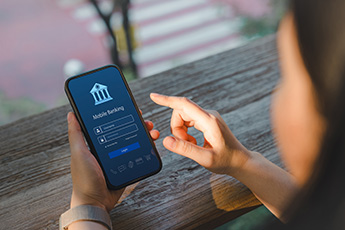Today is National Clean Up Your Room Day. We had no idea that there was such a day, but it was likely recommended by parents nationwide who contend with their children’s messy rooms. That rule of seven – that you need to hear or see something 7x before it sticks may not apply to children and cleaning up their rooms. But, it does apply to customers and advertising. Trying to reach new customers with the right message 7x is a feat for many bankers. A relatively easy and effective way to do this is through mobile advertising. Many companies are turning their attention to mobile advertising for a few reasons. First of all, App Annie reports that the average American used their mobile device for 4.1 hours each day in 2021. Nearly 80% of smartphone users have made purchases on e-commerce sites with their mobile devices during the past six months, according to data from OuterBox. It is not surprising that mobile advertising spending in the US is forecasted to hit $137.13B in 2022. With so many people browsing and shopping on their devices, community financial institutions (CFIs) should include effective mobile advertising in their marketing plans to attract new customers. Let’s dig a little deeper into mobile advertising.Types of mobile advertising
- Geolocation ads are ads that target users when they are in the proximity of their “store”. Customers expect search engine ads to “understand” where they are to make shopping easy for them. When mobile ads include local contact information such as a local phone number or the nearest location’s physical address, 60% of consumers use it to find or call a business. Why not be that business?
- Audio advertising through local online content, especially podcasts and music streaming services, is increasingly popular. According to the Interpublic Group’s media unit Magna, spending on digital audio ads is on track for a 14% increase this year, from $5B in 2021 to $5.7B. By contrast, traditional radio advertising is up just 3%.
- In-app ads are ads within an app, such as your own banking app or even your partners’ apps. These can help create cross-selling opportunities when your customers are ready, without the cost of advertising paid to search engines like Google or other outside companies. If the advertising is appropriately targeted, your customers will even thank you for it.
- Partnership advertising lets you combine efforts with another business. You might advertise your automobile loan rates and terms, for instance, in an ad that also highlights a local automotive dealership. Customers that are looking for a larger purchase and have an easy way to finance it will likely be more incentivized to make a decision promptly.
- Social media and YouTube advertising are increasingly common. It is not surprising as 80% of shoppers watch a YouTube video about a planned purchase at the beginning of their process and mobile device users rack up 70% of overall YouTube watching time. Campaigns on Facebook, Twitter, and other social media channels can successfully capture viewer attention, with Facebook enjoying a 9-10% conversion rate.
Now that you know what types of mobile ads are used, are you ready to dip your toe into the mobile advertising waters? If you are, you will need to come up with the right content. What content is appropriate for a mobile ad campaign?
The key is short, visual, and impactful. You will only grab a potential customer’s attention on their device for 1.5 to 5 seconds before they move on. Here are three forms of mobile content that can be attention-grabbing.
The key is short, visual, and impactful. You will only grab a potential customer’s attention on their device for 1.5 to 5 seconds before they move on. Here are three forms of mobile content that can be attention-grabbing.
- Short videos. Many people enjoy watching videos on social media. With the right message, a video could be quite memorable and actionable.
- Blogs. Using a blog on a mobile-responsive website provides potential customers with valuable information or perspectives that can tee up interest in your products and services and lets them search deep into your site. All the while, you can track them and learn their behaviors.
- Checklists. Potential customers enjoy content that provides value rather than just selling them on product benefits. So offer steps they should take to reach their goals, whether that’s starting a new business or managing cash flow better. Giving them helpful information like this will likely have them coming back to you.
By tracking views and responses, CFIs can learn more about their prospects using digital marketing and customize content accordingly. How many of them click on a link or follow through on contacting the institution? Adjust until the customer response rate reaches its goal or follows the process you intended. Then periodically adjust the content and refresh it, as customers want up-to-date ideas and content.With 77% of the US population owning smartphones, mobile advertising is becoming more popular. Finding new customers where they are geographically and when they need new products and services is enticing to community financial institutions. Is today the day to start reaching out to these new mobile customers?




